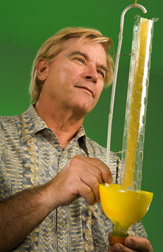Built, Patented . . . A Better Fly Trap!
No one likes to have to say, “Hey, there’s a fly in my soup!”
An ingenious trap invented by Agricultural Research Service scientists could soon help prevent the need to ever make that distasteful statement again. Named “Flybrella” because of its resemblance to an upside-down umbrella, this low-profile pest control technology was awarded a patent in 2005. Now, its inventors are seeking a licensing partner to commercialize the invention.
Flybrella was designed by entomologist Jerome Hogsette and recently retired chemist David Carlson at the ARS Mosquito and Fly Research Unit of the Center for Medical, Agricultural, and Veterinary Entomology, at Gainesville, Florida. The trap attracts, kills, and retains the bodies of house flies and other flying insects. Flybrella is especially promising as an alternative means of fly control in areas where food products are stored or prepared, since it can supplement or replace chemical pest control methods in these sensitive areas.
“Effective traps for managing nuisance flies indoors are generally limited to ultraviolet light traps and those based on sticky papers or sticky ribbons without toxic chemicals,” says Hogsette. “Because they’re unsightly, traps are often concealed to keep the paper and dead flies out of public view.
“Flybrella is small and lightweight, suitable for hanging on overhead water and power lines where flies tend to rest in commercial kitchens and bakeries,” explains Hogsette. About 6 feet above the floor seems to be the best height for locating the trap.
Safe and inexpensive to produce, Flybrella uses a commercially available nontoxic attractant to lure hungry flies to their doom. In less than 15 seconds, they are killed by a poison bait, which is enclosed in a perforated tube. The dead flies fall into a dome-shaped plastic container at the base of the trap. The bait and toxicant stay effective for about 3 months.
QuickStrike, a toxic strip that Hogsette helped develop for agricultural use in the early 1990s, is used in the Flybrella. QuickStrike has been very successful at controlling flies in poultry facilities. One of its ingredients is Muscalure, a sex attractant for flies discovered by Carlson that’s widely used in commercial fly baits.
In controlled laboratory studies, two Flybrellas captured about 98 percent of released flies. The trap could be used in supermarkets, restaurants, and any commercial establishment where food is prepared or stored.
“Flybrella answers a need in the commercial setting to discreetly attract, kill, and collect flies that can be a potential health hazard or a turnoff to customers,” says Hogsette.—By Sharon Durham, Agricultural Research Service Information Staff.
This research is part of Veterinary, Medical, and Urban Entomology, an ARS National Research Program (#104) described on the World Wide Web at www.nps.ars.usda.gov.
Jerome A. Hogsette is in the Mosquito and Fly Research Unit, USDA-ARS Center for Medical and Veterinary Entomology, 1600-1700 S.W. 23rd Dr., Gainesville, FL 32608; phone (352) 374-5912, fax (352) 374-5922.
"Built, Patented . . . A Better Fly Trap!" was published in the March 2007 issue of Agricultural Research magazine.







